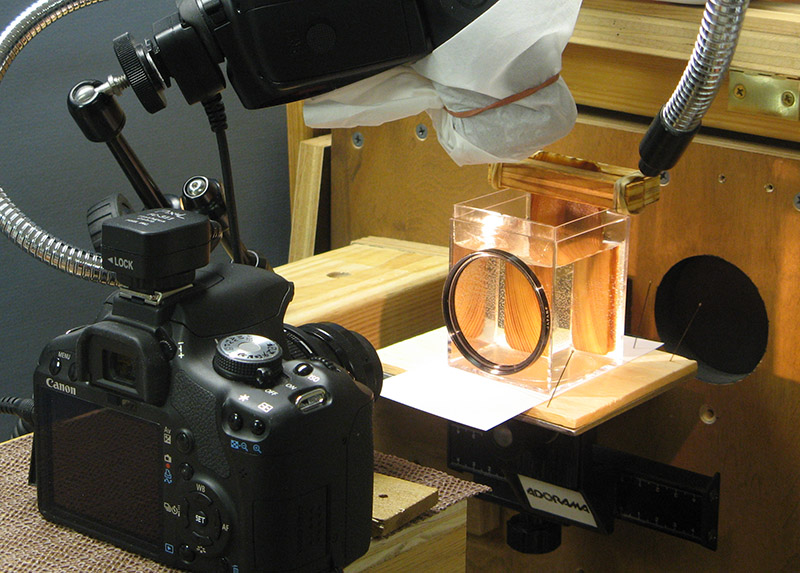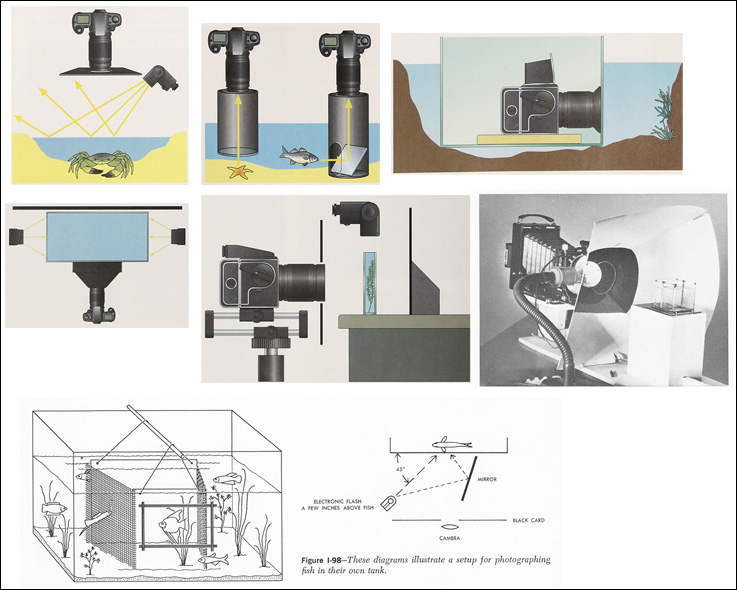Glycerine and higher magnifications would surely make meniscus much harder to deal with. But at about 1x, shooting top down in water without intervening glass, I have not found it to be a difficult issue. Simply start with the specimen as high up in the water as possible to minimize the amount of water between camera and subject, but lower it a bit if meniscus problems show up in a test shot. This discard from my 2006 project illustrates a subject that is not quite low enough in the water, and shows concentric rings around several branch tips. Other shots, with the specimen lowered a millimeter or two lower, were fine.
Discarded shot uncropped, about 1x-3x* (image from before my stacking days, and so DOF is limited):

Pixel-level crop of the region too close to the water's surface, where meniscus effects are evident:

This plant is
Ceratophyllum demersum, the genus being commonly known as "coontail." The bubbles are being released by the plant, which was rapidly photosynthesizing under my flash and focusing lights. (Nikkor AF-D micro 105 f/2.8 at f/22 on a D200. Image taken as part of a study under a grant from the Geauga Park District in Geauga Country, Ohio.)
. . .working with a piece of clean glass that was intended to be photographed through.
I'd note that my aquarium glass, on the side through which I tried shooting before switching to the top-down, glass-free approach, was quite clean; I had previously cleaned it as I would any optical element I was planning to shoot through. No telling how big a problem it was that this glass was not intended to be photographed through. I suspect the big bugaboo was that this aquarium's glass is about 3.6mm thick, which, at around 1x-3x* magnification, seemed to impose a penalty (spherical aberration?) that I could not get around no matter how carefully I placed my camera and lights.
Based on a quick search, I see Hoya lists 1mm as the thickness for one of its UV filters, and
ceteris paribus, I'd expect that less thickness means less penalty--so the filter in Rik's test rig should be much better than the glass in my aquarium on that score alone. A cover slip is typically about 0.17 mm, and can be even thinner--hence my choice of this item for really small stuff I intend to shoot from the side. But if one's image permits it, I'd strongly consider "no glass at all."
The situation I was solving for with these pond weeds seems reasonably close to that of corals between the size of a dime and a ping-pong ball, so perhaps the protocol I used may work for Drbluethumb. Rik's situation with subjects in glycerine at 5x seems quite different--and much more difficult. (Actually, it's simple, Rik--just rinse the glycerine off the specimens and float them in liquid helium!

)
--Chris
*Since posting this, I've edited two magnification references from the original "1x" to "1-3x," to reflect my fuzzy memory of shooting this six-year-old outtake. The specimen was smaller than most coontails, and my sense is that 1x is pretty close. But in the absence of notes, I'd like to indicate some level of imprecision. The original specimen was subsequently mounted on an herbarium sheet, but this sheet is being curated by a university in another state, and so is not convenient for me to measure. Nonetheless, my tests during that project covered the 1x-3x magnification range pretty thoroughly, and what I observed about image degradation from aquarium glass seemed consistent across that range.




